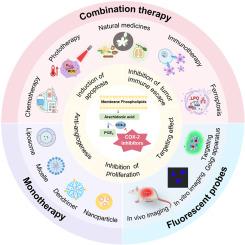Emerging COX-2 inhibitors-based nanotherapeutics for cancer diagnosis and treatment
IF 12.8
1区 医学
Q1 ENGINEERING, BIOMEDICAL
引用次数: 0
Abstract
Increasing evidence has showed that tumorigenesis is closely linked to inflammation, regulated by multiple signaling pathways. Among these, the cyclooxygenase-2/prostaglandin E2 (COX-2/PGE2) axis plays a crucial role in the progression of both inflammation and cancer. Inhibiting the activity of COX-2 can reduce PGE2 secretion, thereby suppressing tumor growth. Therefore, COX-2 inhibitors are considered potential therapeutic agents for cancers. However, their clinical applications are greatly hindered by poor physicochemical properties and serious adverse effects. Fortunately, the advent of nanotechnology offers solutions to these limitations, enhancing drug delivery efficiency and mitigating adverse effects. Given the considerable progress in this area, it is timely to review emerging COX-2 inhibitors-based nanotherapeutics for cancer diagnosis and therapy. In this review, we first outline the various antineoplastic mechanisms of COX-2 inhibitors, then comprehensively summarize COX-2 inhibitors-based nanotherapeutics for cancer monotherapy, combination therapy, and diagnosis. Finally, we highlight and discuss future perspectives and challenges in the development of COX-2 inhibitors-based nanomedicine.

用于癌症诊断和治疗的基于 COX-2 抑制剂的新兴纳米疗法。
越来越多的证据表明,肿瘤的发生与炎症密切相关,并受多种信号通路的调控。其中,环氧化酶-2/前列腺素 E2(COX-2/PGE2)轴在炎症和癌症的发展过程中起着至关重要的作用。抑制 COX-2 的活性可以减少 PGE2 的分泌,从而抑制肿瘤的生长。因此,COX-2 抑制剂被认为是潜在的癌症治疗药物。然而,由于理化性质差和严重的不良反应,它们的临床应用受到很大阻碍。幸运的是,纳米技术的出现为这些限制提供了解决方案,提高了药物输送效率并减轻了不良反应。鉴于该领域取得的长足进步,现在正是回顾基于 COX-2 抑制剂的新兴纳米疗法在癌症诊断和治疗中的应用的好时机。在这篇综述中,我们首先概述了 COX-2 抑制剂的各种抗肿瘤机制,然后全面总结了基于 COX-2 抑制剂的纳米疗法在癌症单药治疗、联合治疗和诊断中的应用。最后,我们强调并讨论了基于 COX-2 抑制剂的纳米药物开发的未来前景和挑战。
本文章由计算机程序翻译,如有差异,请以英文原文为准。
求助全文
约1分钟内获得全文
求助全文
来源期刊

Biomaterials
工程技术-材料科学:生物材料
CiteScore
26.00
自引率
2.90%
发文量
565
审稿时长
46 days
期刊介绍:
Biomaterials is an international journal covering the science and clinical application of biomaterials. A biomaterial is now defined as a substance that has been engineered to take a form which, alone or as part of a complex system, is used to direct, by control of interactions with components of living systems, the course of any therapeutic or diagnostic procedure. It is the aim of the journal to provide a peer-reviewed forum for the publication of original papers and authoritative review and opinion papers dealing with the most important issues facing the use of biomaterials in clinical practice. The scope of the journal covers the wide range of physical, biological and chemical sciences that underpin the design of biomaterials and the clinical disciplines in which they are used. These sciences include polymer synthesis and characterization, drug and gene vector design, the biology of the host response, immunology and toxicology and self assembly at the nanoscale. Clinical applications include the therapies of medical technology and regenerative medicine in all clinical disciplines, and diagnostic systems that reply on innovative contrast and sensing agents. The journal is relevant to areas such as cancer diagnosis and therapy, implantable devices, drug delivery systems, gene vectors, bionanotechnology and tissue engineering.
 求助内容:
求助内容: 应助结果提醒方式:
应助结果提醒方式:


